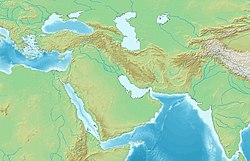Apollonos Hieron
| Location | Turkey |
|---|---|
| Coordinates | 38°2′42″N 28°49′50″E / 38.04500°N 28.83056°E |
| Type | City |
Apollonos Hieron (Greek: Ἀπόλλωνος ἱερόν, "Temple of Apollo")[1] was an ancient city of Lydia.
Location
[edit]It was located about 300 stadia from Pergamon on a hill,[2] but its exact location is unknown.[3]
The inhabitants of the village of Buldan hold that their town is the location[4] of Apollonos Hieron. However, Buldan is known to be the site of Tripolis, and both cities sent separate delegates to the Council of Chalcedon. Ramsay[5] believed that both cities were adjacent to each other and this may explain why Pliny thought the name of Tripolis had previously been Apollonos. He more generally puts it in the Plain of Philadelphia, in the Lykos River Valley.[6]
Apollonos Hieron was known for its temple,[7][8] and is mentioned by Pliny,[9][10] who describes it as small. It is possibly mentioned by Aristides[clarification needed][11] and Strabo.[12] Apollonos Hieron minted its own coins,[13][14][15] of which there are today many examples.
Bishopric
[edit]Apollonos Hieron was also the seat of a bishopric[16] and remains a titular see in the Roman Catholic Church.[17] Bishop Leucius of Apollonos Hieron signed at the Council of Chalcedon.[18]
References
[edit]- ^ APOLLONOS HIERON in William Smith, Dictionary of Greek and Roman Geography (1854) (John Murray, Albemarle Street, 1854).
- ^ John Anthony Cramer, A geographical and historical description of Asia Minor, Volume 1 (The University Press, 1832) p455.
- ^ T. Drew Bear ,Apollonos Hieron.
- ^ History of our town, Buldan Archived September 14, 2014, at the Wayback Machine.
- ^ Sir William Mitchell Ramsay, The Cities and Bishoprics of Phrygia: Being an Essay of the Local History of Phrygia from the Earliest Times to the Turkish Conquest, Volume 2 (Clarendon Press, 1897) p178-179.
- ^ W. M. Ramsay, The Historical Geography of Asia Minor p124.
- ^ Alexander MacBean, Samuel Johnson,A Dictionary of Ancient Geography: Explaining the Local Appellations in Sacred, Grecian, and Roman History (G. Robinson, 1773)pA-P.
- ^ John Anthony Cramer, A geographical and historical description of Asia Minor, Volume 1 (The University Press, 1832) p 454.
- ^ Pliny (5.29).
- ^ Alexander MacBean, Samuel Johnson,A Dictionary of Ancient Geography: Explaining the Local Appellations in Sacred, Grecian, and Roman History (G. Robinson, 1773)pA-P.
- ^ Aristides, 1.
- ^ John Anthony Cramer, A geographical description of Asia Minor Vol.1 (The University Press, 1832), p. 455.
- ^ Ancient Coinage of Lydia, Apollonoshieron.
- ^ Coin of Apollonos Hieron at Yale University Art Gallery.
- ^ W. M. Ramsay,The Historical Geography of Asia Minor (Cambridge University Press, 2010) p120.
- ^ Hierocles, Synecdemus p670.
- ^ Apollonos-Hieron (Titular See) at Catholic heriachy.org.
- ^ Richard Price, Michael Gaddis, The Acts of the Council of Chalcedon, Volume 1(Liverpool University Press, 2005) p104.
- Ancient Greek archaeological sites in Turkey
- Catholic titular sees in Asia
- Dioceses established in the 1st century
- Greek colonies in Anatolia
- Populated places in ancient Lydia
- Former populated places in Turkey
- Temples of Apollo
- History of Denizli Province
- Ancient Lydia geography stubs
- Denizli Province geography stubs


